Comprehensive Analysis of Decreasing Oil Prices in Kuwait
VerifiedAdded on 2022/11/28
|13
|3981
|186
Project
AI Summary
This project undertakes a comprehensive analysis of the decreasing oil prices in Kuwait, a nation heavily reliant on oil revenue. It delves into the reasons behind the price decline, including the influence of the US dollar's strength, OPEC's internal dynamics, and global supply and demand dynamics. The study examines both the internal and external effects, such as reduced government revenue, balance of payment issues, and diplomatic implications. The project incorporates a regression analysis to identify the key factors influencing oil prices in Kuwait. Furthermore, it explores the impacts on Kuwait's economy, including infrastructure development, foreign direct investment, GDP, and inflation. The role of OPEC and the country's procedures and policies in addressing the problem are also discussed, along with potential alternatives to oil dependence. The project utilizes data and regression analysis to provide a well-rounded understanding of the situation.
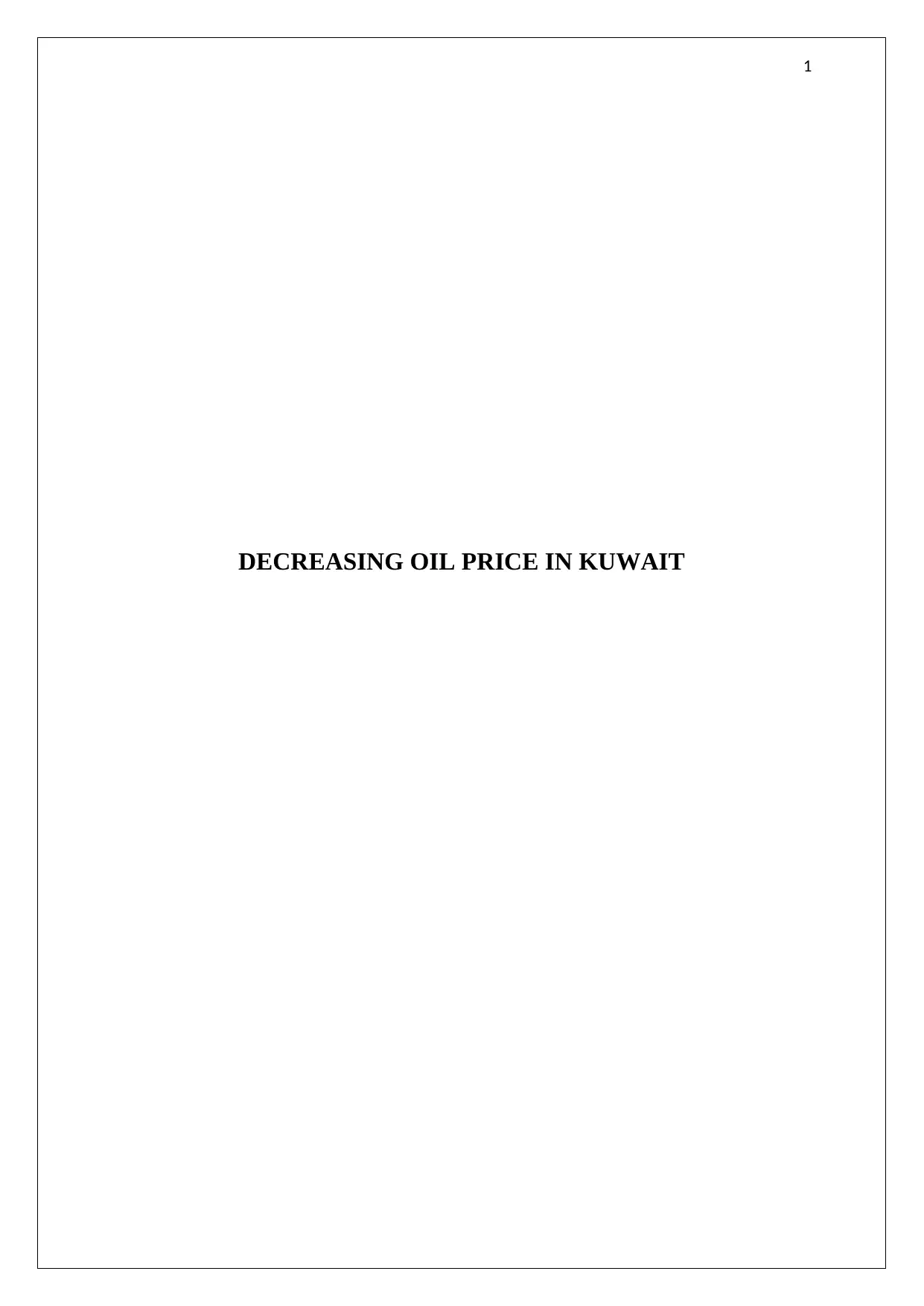
1
DECREASING OIL PRICE IN KUWAIT
DECREASING OIL PRICE IN KUWAIT
Paraphrase This Document
Need a fresh take? Get an instant paraphrase of this document with our AI Paraphraser
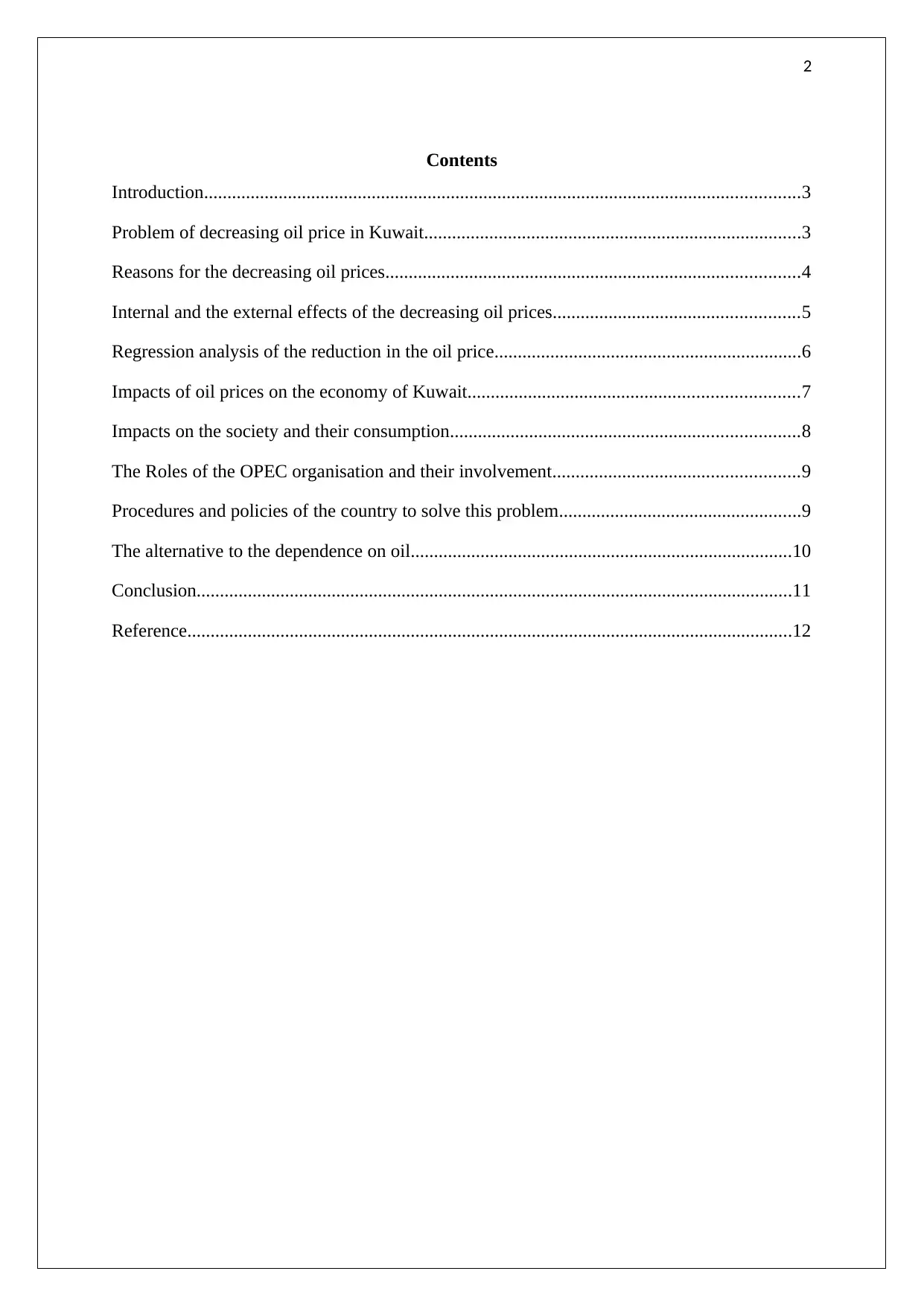
2
Contents
Introduction................................................................................................................................3
Problem of decreasing oil price in Kuwait.................................................................................3
Reasons for the decreasing oil prices.........................................................................................4
Internal and the external effects of the decreasing oil prices.....................................................5
Regression analysis of the reduction in the oil price..................................................................6
Impacts of oil prices on the economy of Kuwait.......................................................................7
Impacts on the society and their consumption...........................................................................8
The Roles of the OPEC organisation and their involvement.....................................................9
Procedures and policies of the country to solve this problem....................................................9
The alternative to the dependence on oil..................................................................................10
Conclusion................................................................................................................................11
Reference..................................................................................................................................12
Contents
Introduction................................................................................................................................3
Problem of decreasing oil price in Kuwait.................................................................................3
Reasons for the decreasing oil prices.........................................................................................4
Internal and the external effects of the decreasing oil prices.....................................................5
Regression analysis of the reduction in the oil price..................................................................6
Impacts of oil prices on the economy of Kuwait.......................................................................7
Impacts on the society and their consumption...........................................................................8
The Roles of the OPEC organisation and their involvement.....................................................9
Procedures and policies of the country to solve this problem....................................................9
The alternative to the dependence on oil..................................................................................10
Conclusion................................................................................................................................11
Reference..................................................................................................................................12
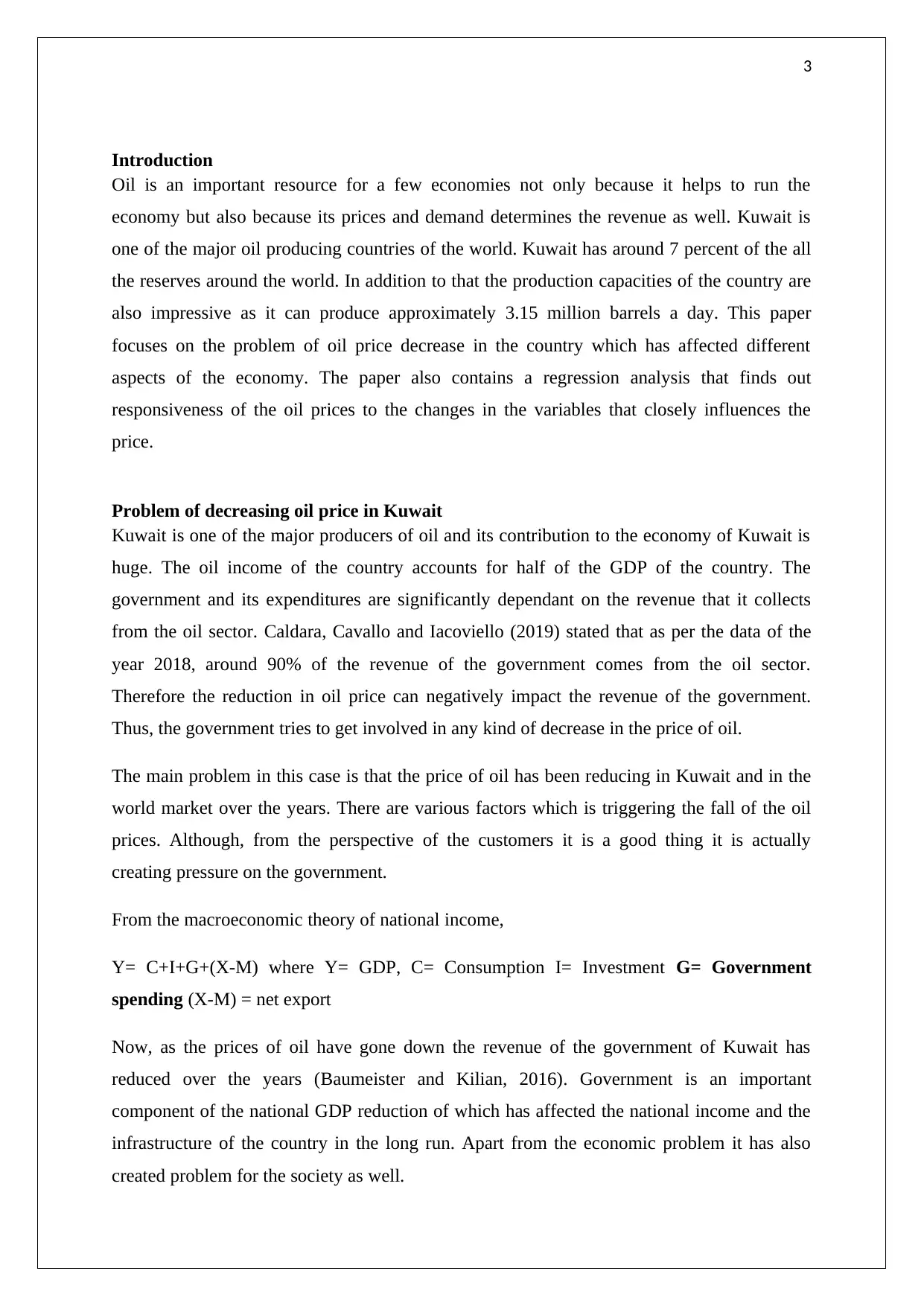
3
Introduction
Oil is an important resource for a few economies not only because it helps to run the
economy but also because its prices and demand determines the revenue as well. Kuwait is
one of the major oil producing countries of the world. Kuwait has around 7 percent of the all
the reserves around the world. In addition to that the production capacities of the country are
also impressive as it can produce approximately 3.15 million barrels a day. This paper
focuses on the problem of oil price decrease in the country which has affected different
aspects of the economy. The paper also contains a regression analysis that finds out
responsiveness of the oil prices to the changes in the variables that closely influences the
price.
Problem of decreasing oil price in Kuwait
Kuwait is one of the major producers of oil and its contribution to the economy of Kuwait is
huge. The oil income of the country accounts for half of the GDP of the country. The
government and its expenditures are significantly dependant on the revenue that it collects
from the oil sector. Caldara, Cavallo and Iacoviello (2019) stated that as per the data of the
year 2018, around 90% of the revenue of the government comes from the oil sector.
Therefore the reduction in oil price can negatively impact the revenue of the government.
Thus, the government tries to get involved in any kind of decrease in the price of oil.
The main problem in this case is that the price of oil has been reducing in Kuwait and in the
world market over the years. There are various factors which is triggering the fall of the oil
prices. Although, from the perspective of the customers it is a good thing it is actually
creating pressure on the government.
From the macroeconomic theory of national income,
Y= C+I+G+(X-M) where Y= GDP, C= Consumption I= Investment G= Government
spending (X-M) = net export
Now, as the prices of oil have gone down the revenue of the government of Kuwait has
reduced over the years (Baumeister and Kilian, 2016). Government is an important
component of the national GDP reduction of which has affected the national income and the
infrastructure of the country in the long run. Apart from the economic problem it has also
created problem for the society as well.
Introduction
Oil is an important resource for a few economies not only because it helps to run the
economy but also because its prices and demand determines the revenue as well. Kuwait is
one of the major oil producing countries of the world. Kuwait has around 7 percent of the all
the reserves around the world. In addition to that the production capacities of the country are
also impressive as it can produce approximately 3.15 million barrels a day. This paper
focuses on the problem of oil price decrease in the country which has affected different
aspects of the economy. The paper also contains a regression analysis that finds out
responsiveness of the oil prices to the changes in the variables that closely influences the
price.
Problem of decreasing oil price in Kuwait
Kuwait is one of the major producers of oil and its contribution to the economy of Kuwait is
huge. The oil income of the country accounts for half of the GDP of the country. The
government and its expenditures are significantly dependant on the revenue that it collects
from the oil sector. Caldara, Cavallo and Iacoviello (2019) stated that as per the data of the
year 2018, around 90% of the revenue of the government comes from the oil sector.
Therefore the reduction in oil price can negatively impact the revenue of the government.
Thus, the government tries to get involved in any kind of decrease in the price of oil.
The main problem in this case is that the price of oil has been reducing in Kuwait and in the
world market over the years. There are various factors which is triggering the fall of the oil
prices. Although, from the perspective of the customers it is a good thing it is actually
creating pressure on the government.
From the macroeconomic theory of national income,
Y= C+I+G+(X-M) where Y= GDP, C= Consumption I= Investment G= Government
spending (X-M) = net export
Now, as the prices of oil have gone down the revenue of the government of Kuwait has
reduced over the years (Baumeister and Kilian, 2016). Government is an important
component of the national GDP reduction of which has affected the national income and the
infrastructure of the country in the long run. Apart from the economic problem it has also
created problem for the society as well.
⊘ This is a preview!⊘
Do you want full access?
Subscribe today to unlock all pages.

Trusted by 1+ million students worldwide
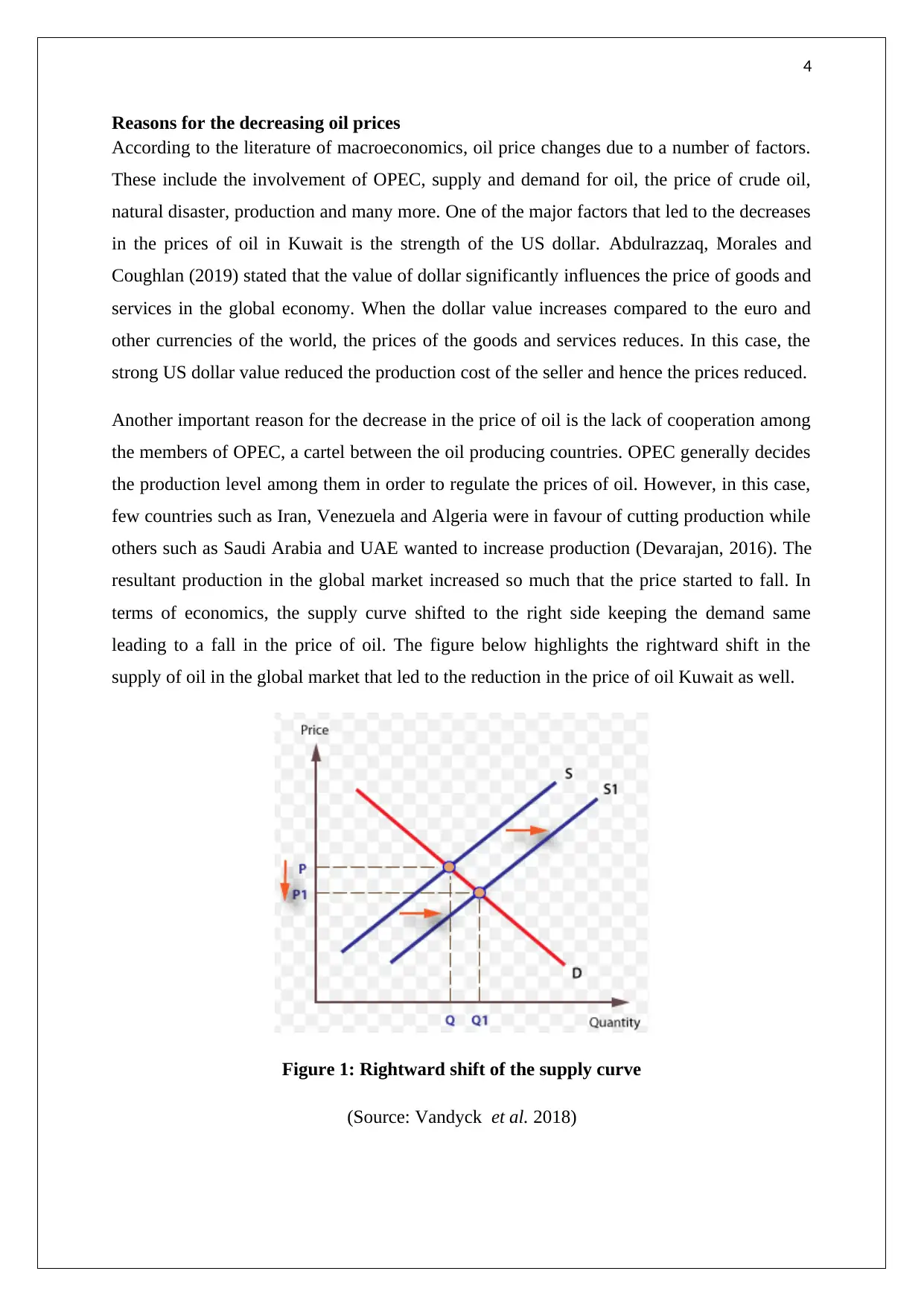
4
Reasons for the decreasing oil prices
According to the literature of macroeconomics, oil price changes due to a number of factors.
These include the involvement of OPEC, supply and demand for oil, the price of crude oil,
natural disaster, production and many more. One of the major factors that led to the decreases
in the prices of oil in Kuwait is the strength of the US dollar. Abdulrazzaq, Morales and
Coughlan (2019) stated that the value of dollar significantly influences the price of goods and
services in the global economy. When the dollar value increases compared to the euro and
other currencies of the world, the prices of the goods and services reduces. In this case, the
strong US dollar value reduced the production cost of the seller and hence the prices reduced.
Another important reason for the decrease in the price of oil is the lack of cooperation among
the members of OPEC, a cartel between the oil producing countries. OPEC generally decides
the production level among them in order to regulate the prices of oil. However, in this case,
few countries such as Iran, Venezuela and Algeria were in favour of cutting production while
others such as Saudi Arabia and UAE wanted to increase production (Devarajan, 2016). The
resultant production in the global market increased so much that the price started to fall. In
terms of economics, the supply curve shifted to the right side keeping the demand same
leading to a fall in the price of oil. The figure below highlights the rightward shift in the
supply of oil in the global market that led to the reduction in the price of oil Kuwait as well.
Figure 1: Rightward shift of the supply curve
(Source: Vandyck et al. 2018)
Reasons for the decreasing oil prices
According to the literature of macroeconomics, oil price changes due to a number of factors.
These include the involvement of OPEC, supply and demand for oil, the price of crude oil,
natural disaster, production and many more. One of the major factors that led to the decreases
in the prices of oil in Kuwait is the strength of the US dollar. Abdulrazzaq, Morales and
Coughlan (2019) stated that the value of dollar significantly influences the price of goods and
services in the global economy. When the dollar value increases compared to the euro and
other currencies of the world, the prices of the goods and services reduces. In this case, the
strong US dollar value reduced the production cost of the seller and hence the prices reduced.
Another important reason for the decrease in the price of oil is the lack of cooperation among
the members of OPEC, a cartel between the oil producing countries. OPEC generally decides
the production level among them in order to regulate the prices of oil. However, in this case,
few countries such as Iran, Venezuela and Algeria were in favour of cutting production while
others such as Saudi Arabia and UAE wanted to increase production (Devarajan, 2016). The
resultant production in the global market increased so much that the price started to fall. In
terms of economics, the supply curve shifted to the right side keeping the demand same
leading to a fall in the price of oil. The figure below highlights the rightward shift in the
supply of oil in the global market that led to the reduction in the price of oil Kuwait as well.
Figure 1: Rightward shift of the supply curve
(Source: Vandyck et al. 2018)
Paraphrase This Document
Need a fresh take? Get an instant paraphrase of this document with our AI Paraphraser
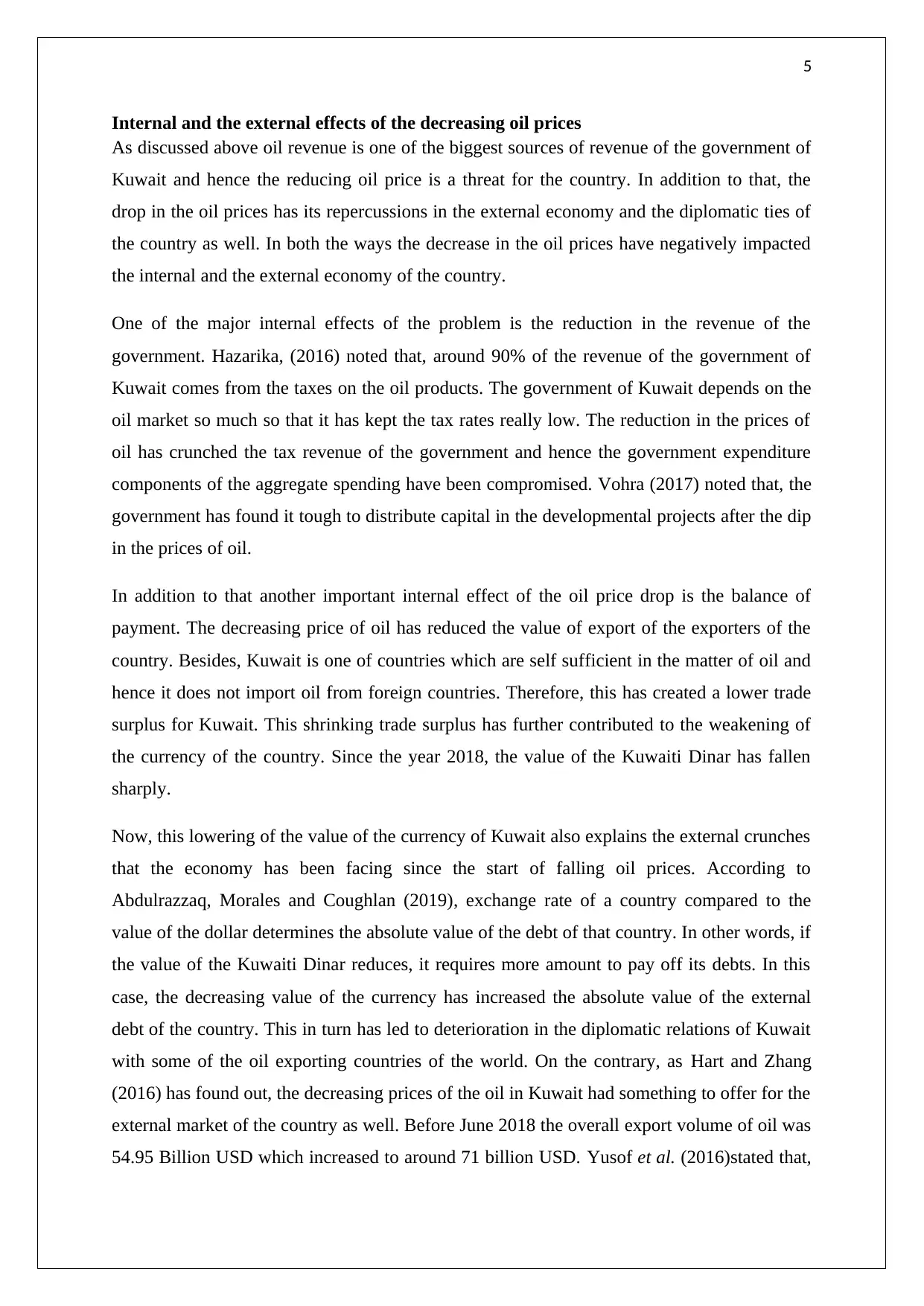
5
Internal and the external effects of the decreasing oil prices
As discussed above oil revenue is one of the biggest sources of revenue of the government of
Kuwait and hence the reducing oil price is a threat for the country. In addition to that, the
drop in the oil prices has its repercussions in the external economy and the diplomatic ties of
the country as well. In both the ways the decrease in the oil prices have negatively impacted
the internal and the external economy of the country.
One of the major internal effects of the problem is the reduction in the revenue of the
government. Hazarika, (2016) noted that, around 90% of the revenue of the government of
Kuwait comes from the taxes on the oil products. The government of Kuwait depends on the
oil market so much so that it has kept the tax rates really low. The reduction in the prices of
oil has crunched the tax revenue of the government and hence the government expenditure
components of the aggregate spending have been compromised. Vohra (2017) noted that, the
government has found it tough to distribute capital in the developmental projects after the dip
in the prices of oil.
In addition to that another important internal effect of the oil price drop is the balance of
payment. The decreasing price of oil has reduced the value of export of the exporters of the
country. Besides, Kuwait is one of countries which are self sufficient in the matter of oil and
hence it does not import oil from foreign countries. Therefore, this has created a lower trade
surplus for Kuwait. This shrinking trade surplus has further contributed to the weakening of
the currency of the country. Since the year 2018, the value of the Kuwaiti Dinar has fallen
sharply.
Now, this lowering of the value of the currency of Kuwait also explains the external crunches
that the economy has been facing since the start of falling oil prices. According to
Abdulrazzaq, Morales and Coughlan (2019), exchange rate of a country compared to the
value of the dollar determines the absolute value of the debt of that country. In other words, if
the value of the Kuwaiti Dinar reduces, it requires more amount to pay off its debts. In this
case, the decreasing value of the currency has increased the absolute value of the external
debt of the country. This in turn has led to deterioration in the diplomatic relations of Kuwait
with some of the oil exporting countries of the world. On the contrary, as Hart and Zhang
(2016) has found out, the decreasing prices of the oil in Kuwait had something to offer for the
external market of the country as well. Before June 2018 the overall export volume of oil was
54.95 Billion USD which increased to around 71 billion USD. Yusof et al. (2016)stated that,
Internal and the external effects of the decreasing oil prices
As discussed above oil revenue is one of the biggest sources of revenue of the government of
Kuwait and hence the reducing oil price is a threat for the country. In addition to that, the
drop in the oil prices has its repercussions in the external economy and the diplomatic ties of
the country as well. In both the ways the decrease in the oil prices have negatively impacted
the internal and the external economy of the country.
One of the major internal effects of the problem is the reduction in the revenue of the
government. Hazarika, (2016) noted that, around 90% of the revenue of the government of
Kuwait comes from the taxes on the oil products. The government of Kuwait depends on the
oil market so much so that it has kept the tax rates really low. The reduction in the prices of
oil has crunched the tax revenue of the government and hence the government expenditure
components of the aggregate spending have been compromised. Vohra (2017) noted that, the
government has found it tough to distribute capital in the developmental projects after the dip
in the prices of oil.
In addition to that another important internal effect of the oil price drop is the balance of
payment. The decreasing price of oil has reduced the value of export of the exporters of the
country. Besides, Kuwait is one of countries which are self sufficient in the matter of oil and
hence it does not import oil from foreign countries. Therefore, this has created a lower trade
surplus for Kuwait. This shrinking trade surplus has further contributed to the weakening of
the currency of the country. Since the year 2018, the value of the Kuwaiti Dinar has fallen
sharply.
Now, this lowering of the value of the currency of Kuwait also explains the external crunches
that the economy has been facing since the start of falling oil prices. According to
Abdulrazzaq, Morales and Coughlan (2019), exchange rate of a country compared to the
value of the dollar determines the absolute value of the debt of that country. In other words, if
the value of the Kuwaiti Dinar reduces, it requires more amount to pay off its debts. In this
case, the decreasing value of the currency has increased the absolute value of the external
debt of the country. This in turn has led to deterioration in the diplomatic relations of Kuwait
with some of the oil exporting countries of the world. On the contrary, as Hart and Zhang
(2016) has found out, the decreasing prices of the oil in Kuwait had something to offer for the
external market of the country as well. Before June 2018 the overall export volume of oil was
54.95 Billion USD which increased to around 71 billion USD. Yusof et al. (2016)stated that,

6
the most important reason for the increase in the export volume is the developing economies
of the world which were trying to take advantage of the low prices of oil in the market of
Kuwait. However, the gains have been strongly outplayed by the loss it has occurred due to
the reduction in the government revenue.
Regression analysis of the reduction in the oil price
Regression is a statistical operation that finds out the change in the dependant variable
corresponding to the changes in the independent variable. In this case, the price of the oil in
Kuwait is the dependant variable and the factors such as the value of US dollars, price of
crude oil, production of oil are the independent variable. The regression analysis carried out
below shows the influences of each of the variables on the price of oil in Kuwait.
SUMMARY OUTPUT
Regression Statistics
Multiple R 0.990714093
R Square 0.981514413
Adjusted R Square 0.975352551
Standard Error 3.700196415
Observations 13
ANOVA
df SS MS F Significance F
Regression 3 6542.677349 2180.89245 159.2885991 4.08E-08
Residual 9 123.2230816 13.69145351
Total 12 6665.900431
Coefficients Standard Error t Stat P-value Lower 95%Upper 95%Lower 95.0%Upper 95.0%
Intercept 57.7854613 21.36352774 2.704865134 0.02420012 9.457804 106.1131 9.457804 106.1131
Value US dollar 1.246418258 2.046850145 0.608944559 0.557616981 -3.38388 5.876715 -3.38388 5.876715
Price of Crude oil 1.064938961 0.052797923 20.17009199 8.42595E-09 0.945502 1.184376 0.945502 1.184376
Production of oil -1.679733666 0.761631164 -2.205442405 0.05485153 -3.40266 0.043196 -3.40266 0.043196
Table 1: The regression analysis
(Source: Developed by the learner)
The table above shows the regression analysis of taking the data from the year 2007 to 2019.
The analysis of the data shows how, overtime, the prices of oil in Kuwait have changed over
the years and what are the factors that influence the changes. The table 1 shows that, the
regression analysis is a good fit with a R square value of 0.97. It also shows that, price of
crude oil and the value of the US dollar have positive coefficient. That means with one unit
increase in the value of the US dollar the price increases by 1.2464 and with one unit increase
in the price of crude oil, the price increases by 1.06. The p values of the analysis are also
the most important reason for the increase in the export volume is the developing economies
of the world which were trying to take advantage of the low prices of oil in the market of
Kuwait. However, the gains have been strongly outplayed by the loss it has occurred due to
the reduction in the government revenue.
Regression analysis of the reduction in the oil price
Regression is a statistical operation that finds out the change in the dependant variable
corresponding to the changes in the independent variable. In this case, the price of the oil in
Kuwait is the dependant variable and the factors such as the value of US dollars, price of
crude oil, production of oil are the independent variable. The regression analysis carried out
below shows the influences of each of the variables on the price of oil in Kuwait.
SUMMARY OUTPUT
Regression Statistics
Multiple R 0.990714093
R Square 0.981514413
Adjusted R Square 0.975352551
Standard Error 3.700196415
Observations 13
ANOVA
df SS MS F Significance F
Regression 3 6542.677349 2180.89245 159.2885991 4.08E-08
Residual 9 123.2230816 13.69145351
Total 12 6665.900431
Coefficients Standard Error t Stat P-value Lower 95%Upper 95%Lower 95.0%Upper 95.0%
Intercept 57.7854613 21.36352774 2.704865134 0.02420012 9.457804 106.1131 9.457804 106.1131
Value US dollar 1.246418258 2.046850145 0.608944559 0.557616981 -3.38388 5.876715 -3.38388 5.876715
Price of Crude oil 1.064938961 0.052797923 20.17009199 8.42595E-09 0.945502 1.184376 0.945502 1.184376
Production of oil -1.679733666 0.761631164 -2.205442405 0.05485153 -3.40266 0.043196 -3.40266 0.043196
Table 1: The regression analysis
(Source: Developed by the learner)
The table above shows the regression analysis of taking the data from the year 2007 to 2019.
The analysis of the data shows how, overtime, the prices of oil in Kuwait have changed over
the years and what are the factors that influence the changes. The table 1 shows that, the
regression analysis is a good fit with a R square value of 0.97. It also shows that, price of
crude oil and the value of the US dollar have positive coefficient. That means with one unit
increase in the value of the US dollar the price increases by 1.2464 and with one unit increase
in the price of crude oil, the price increases by 1.06. The p values of the analysis are also
⊘ This is a preview!⊘
Do you want full access?
Subscribe today to unlock all pages.

Trusted by 1+ million students worldwide
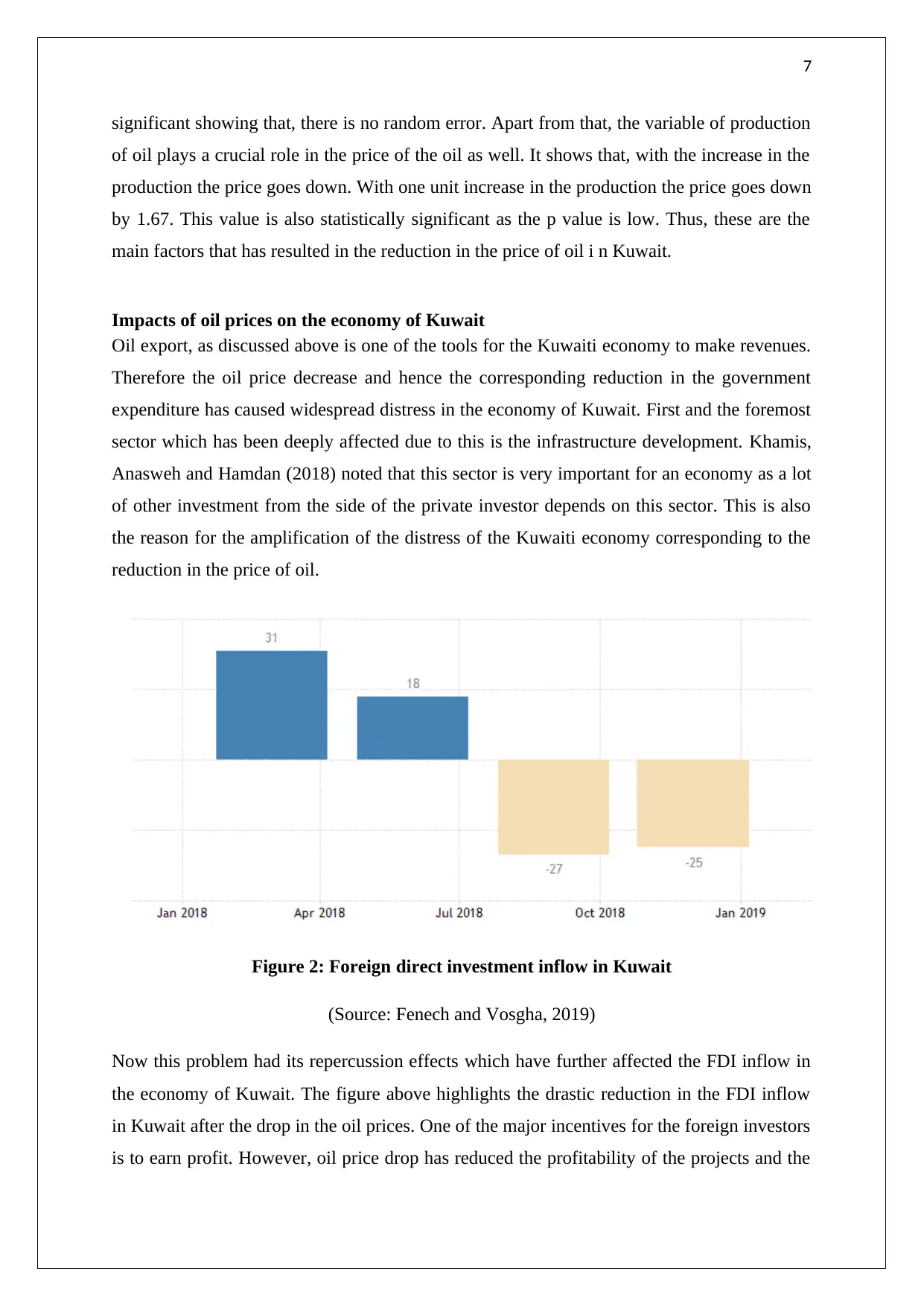
7
significant showing that, there is no random error. Apart from that, the variable of production
of oil plays a crucial role in the price of the oil as well. It shows that, with the increase in the
production the price goes down. With one unit increase in the production the price goes down
by 1.67. This value is also statistically significant as the p value is low. Thus, these are the
main factors that has resulted in the reduction in the price of oil i n Kuwait.
Impacts of oil prices on the economy of Kuwait
Oil export, as discussed above is one of the tools for the Kuwaiti economy to make revenues.
Therefore the oil price decrease and hence the corresponding reduction in the government
expenditure has caused widespread distress in the economy of Kuwait. First and the foremost
sector which has been deeply affected due to this is the infrastructure development. Khamis,
Anasweh and Hamdan (2018) noted that this sector is very important for an economy as a lot
of other investment from the side of the private investor depends on this sector. This is also
the reason for the amplification of the distress of the Kuwaiti economy corresponding to the
reduction in the price of oil.
Figure 2: Foreign direct investment inflow in Kuwait
(Source: Fenech and Vosgha, 2019)
Now this problem had its repercussion effects which have further affected the FDI inflow in
the economy of Kuwait. The figure above highlights the drastic reduction in the FDI inflow
in Kuwait after the drop in the oil prices. One of the major incentives for the foreign investors
is to earn profit. However, oil price drop has reduced the profitability of the projects and the
significant showing that, there is no random error. Apart from that, the variable of production
of oil plays a crucial role in the price of the oil as well. It shows that, with the increase in the
production the price goes down. With one unit increase in the production the price goes down
by 1.67. This value is also statistically significant as the p value is low. Thus, these are the
main factors that has resulted in the reduction in the price of oil i n Kuwait.
Impacts of oil prices on the economy of Kuwait
Oil export, as discussed above is one of the tools for the Kuwaiti economy to make revenues.
Therefore the oil price decrease and hence the corresponding reduction in the government
expenditure has caused widespread distress in the economy of Kuwait. First and the foremost
sector which has been deeply affected due to this is the infrastructure development. Khamis,
Anasweh and Hamdan (2018) noted that this sector is very important for an economy as a lot
of other investment from the side of the private investor depends on this sector. This is also
the reason for the amplification of the distress of the Kuwaiti economy corresponding to the
reduction in the price of oil.
Figure 2: Foreign direct investment inflow in Kuwait
(Source: Fenech and Vosgha, 2019)
Now this problem had its repercussion effects which have further affected the FDI inflow in
the economy of Kuwait. The figure above highlights the drastic reduction in the FDI inflow
in Kuwait after the drop in the oil prices. One of the major incentives for the foreign investors
is to earn profit. However, oil price drop has reduced the profitability of the projects and the
Paraphrase This Document
Need a fresh take? Get an instant paraphrase of this document with our AI Paraphraser
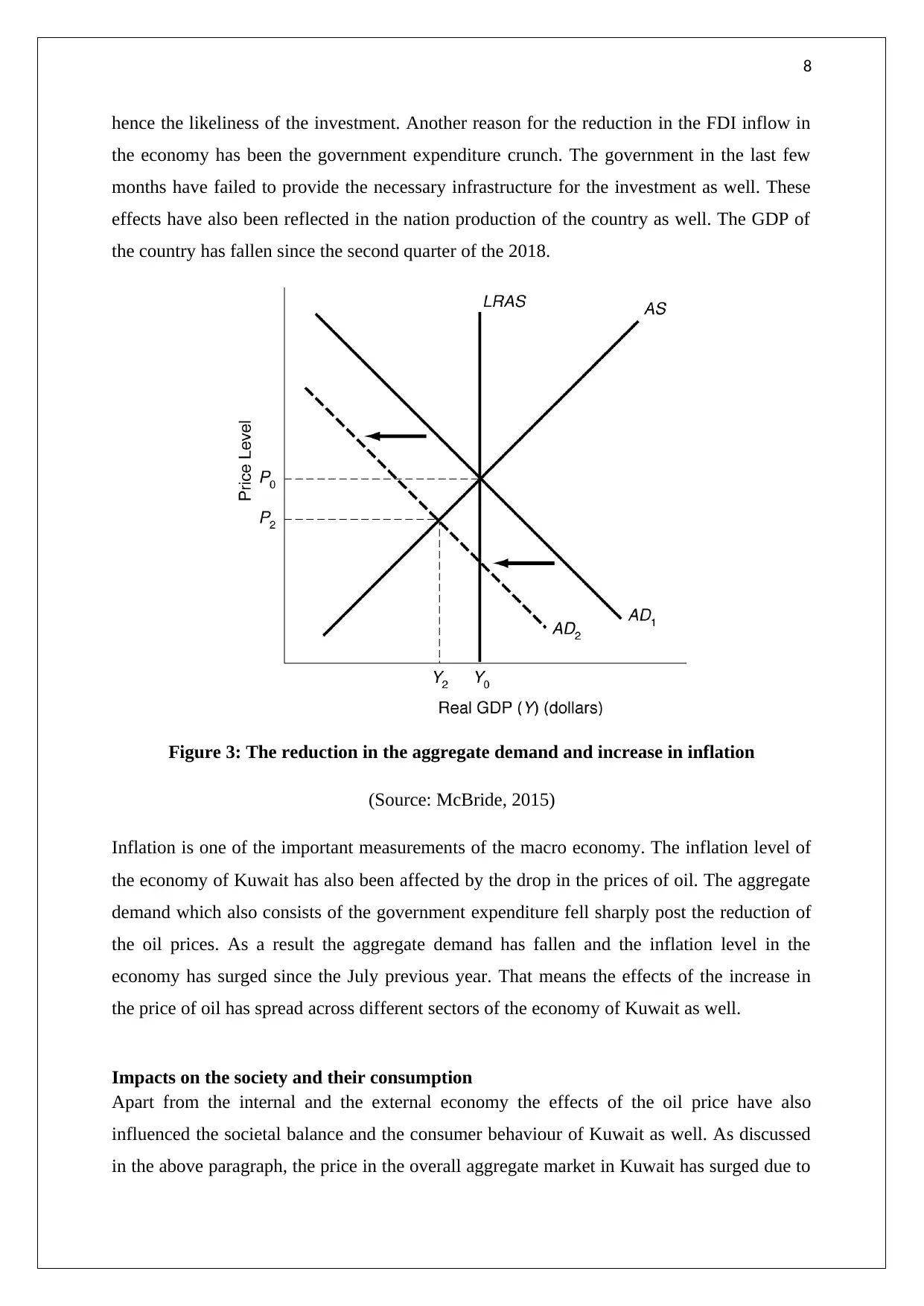
8
hence the likeliness of the investment. Another reason for the reduction in the FDI inflow in
the economy has been the government expenditure crunch. The government in the last few
months have failed to provide the necessary infrastructure for the investment as well. These
effects have also been reflected in the nation production of the country as well. The GDP of
the country has fallen since the second quarter of the 2018.
Figure 3: The reduction in the aggregate demand and increase in inflation
(Source: McBride, 2015)
Inflation is one of the important measurements of the macro economy. The inflation level of
the economy of Kuwait has also been affected by the drop in the prices of oil. The aggregate
demand which also consists of the government expenditure fell sharply post the reduction of
the oil prices. As a result the aggregate demand has fallen and the inflation level in the
economy has surged since the July previous year. That means the effects of the increase in
the price of oil has spread across different sectors of the economy of Kuwait as well.
Impacts on the society and their consumption
Apart from the internal and the external economy the effects of the oil price have also
influenced the societal balance and the consumer behaviour of Kuwait as well. As discussed
in the above paragraph, the price in the overall aggregate market in Kuwait has surged due to
hence the likeliness of the investment. Another reason for the reduction in the FDI inflow in
the economy has been the government expenditure crunch. The government in the last few
months have failed to provide the necessary infrastructure for the investment as well. These
effects have also been reflected in the nation production of the country as well. The GDP of
the country has fallen since the second quarter of the 2018.
Figure 3: The reduction in the aggregate demand and increase in inflation
(Source: McBride, 2015)
Inflation is one of the important measurements of the macro economy. The inflation level of
the economy of Kuwait has also been affected by the drop in the prices of oil. The aggregate
demand which also consists of the government expenditure fell sharply post the reduction of
the oil prices. As a result the aggregate demand has fallen and the inflation level in the
economy has surged since the July previous year. That means the effects of the increase in
the price of oil has spread across different sectors of the economy of Kuwait as well.
Impacts on the society and their consumption
Apart from the internal and the external economy the effects of the oil price have also
influenced the societal balance and the consumer behaviour of Kuwait as well. As discussed
in the above paragraph, the price in the overall aggregate market in Kuwait has surged due to
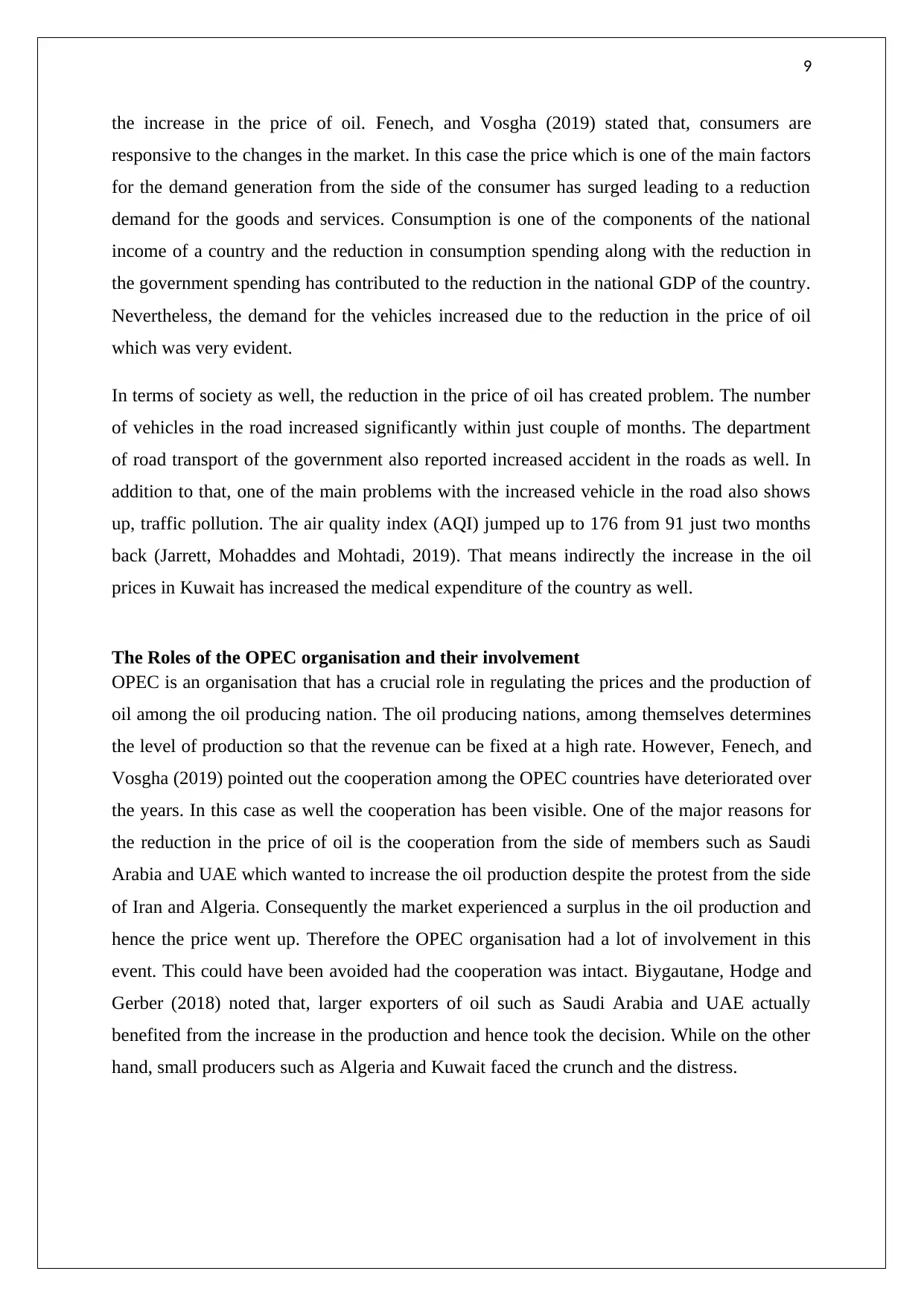
9
the increase in the price of oil. Fenech, and Vosgha (2019) stated that, consumers are
responsive to the changes in the market. In this case the price which is one of the main factors
for the demand generation from the side of the consumer has surged leading to a reduction
demand for the goods and services. Consumption is one of the components of the national
income of a country and the reduction in consumption spending along with the reduction in
the government spending has contributed to the reduction in the national GDP of the country.
Nevertheless, the demand for the vehicles increased due to the reduction in the price of oil
which was very evident.
In terms of society as well, the reduction in the price of oil has created problem. The number
of vehicles in the road increased significantly within just couple of months. The department
of road transport of the government also reported increased accident in the roads as well. In
addition to that, one of the main problems with the increased vehicle in the road also shows
up, traffic pollution. The air quality index (AQI) jumped up to 176 from 91 just two months
back (Jarrett, Mohaddes and Mohtadi, 2019). That means indirectly the increase in the oil
prices in Kuwait has increased the medical expenditure of the country as well.
The Roles of the OPEC organisation and their involvement
OPEC is an organisation that has a crucial role in regulating the prices and the production of
oil among the oil producing nation. The oil producing nations, among themselves determines
the level of production so that the revenue can be fixed at a high rate. However, Fenech, and
Vosgha (2019) pointed out the cooperation among the OPEC countries have deteriorated over
the years. In this case as well the cooperation has been visible. One of the major reasons for
the reduction in the price of oil is the cooperation from the side of members such as Saudi
Arabia and UAE which wanted to increase the oil production despite the protest from the side
of Iran and Algeria. Consequently the market experienced a surplus in the oil production and
hence the price went up. Therefore the OPEC organisation had a lot of involvement in this
event. This could have been avoided had the cooperation was intact. Biygautane, Hodge and
Gerber (2018) noted that, larger exporters of oil such as Saudi Arabia and UAE actually
benefited from the increase in the production and hence took the decision. While on the other
hand, small producers such as Algeria and Kuwait faced the crunch and the distress.
the increase in the price of oil. Fenech, and Vosgha (2019) stated that, consumers are
responsive to the changes in the market. In this case the price which is one of the main factors
for the demand generation from the side of the consumer has surged leading to a reduction
demand for the goods and services. Consumption is one of the components of the national
income of a country and the reduction in consumption spending along with the reduction in
the government spending has contributed to the reduction in the national GDP of the country.
Nevertheless, the demand for the vehicles increased due to the reduction in the price of oil
which was very evident.
In terms of society as well, the reduction in the price of oil has created problem. The number
of vehicles in the road increased significantly within just couple of months. The department
of road transport of the government also reported increased accident in the roads as well. In
addition to that, one of the main problems with the increased vehicle in the road also shows
up, traffic pollution. The air quality index (AQI) jumped up to 176 from 91 just two months
back (Jarrett, Mohaddes and Mohtadi, 2019). That means indirectly the increase in the oil
prices in Kuwait has increased the medical expenditure of the country as well.
The Roles of the OPEC organisation and their involvement
OPEC is an organisation that has a crucial role in regulating the prices and the production of
oil among the oil producing nation. The oil producing nations, among themselves determines
the level of production so that the revenue can be fixed at a high rate. However, Fenech, and
Vosgha (2019) pointed out the cooperation among the OPEC countries have deteriorated over
the years. In this case as well the cooperation has been visible. One of the major reasons for
the reduction in the price of oil is the cooperation from the side of members such as Saudi
Arabia and UAE which wanted to increase the oil production despite the protest from the side
of Iran and Algeria. Consequently the market experienced a surplus in the oil production and
hence the price went up. Therefore the OPEC organisation had a lot of involvement in this
event. This could have been avoided had the cooperation was intact. Biygautane, Hodge and
Gerber (2018) noted that, larger exporters of oil such as Saudi Arabia and UAE actually
benefited from the increase in the production and hence took the decision. While on the other
hand, small producers such as Algeria and Kuwait faced the crunch and the distress.
⊘ This is a preview!⊘
Do you want full access?
Subscribe today to unlock all pages.

Trusted by 1+ million students worldwide
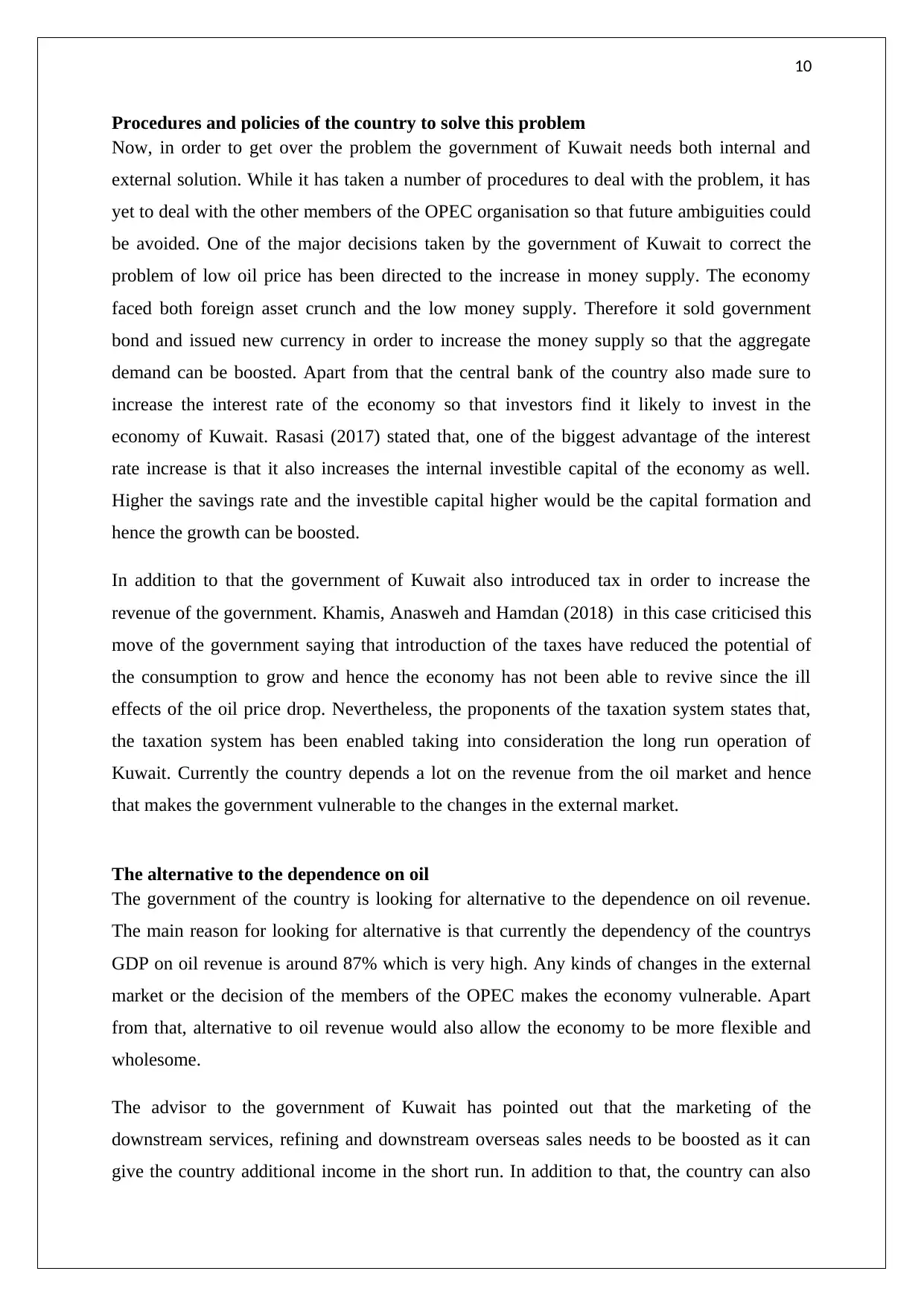
10
Procedures and policies of the country to solve this problem
Now, in order to get over the problem the government of Kuwait needs both internal and
external solution. While it has taken a number of procedures to deal with the problem, it has
yet to deal with the other members of the OPEC organisation so that future ambiguities could
be avoided. One of the major decisions taken by the government of Kuwait to correct the
problem of low oil price has been directed to the increase in money supply. The economy
faced both foreign asset crunch and the low money supply. Therefore it sold government
bond and issued new currency in order to increase the money supply so that the aggregate
demand can be boosted. Apart from that the central bank of the country also made sure to
increase the interest rate of the economy so that investors find it likely to invest in the
economy of Kuwait. Rasasi (2017) stated that, one of the biggest advantage of the interest
rate increase is that it also increases the internal investible capital of the economy as well.
Higher the savings rate and the investible capital higher would be the capital formation and
hence the growth can be boosted.
In addition to that the government of Kuwait also introduced tax in order to increase the
revenue of the government. Khamis, Anasweh and Hamdan (2018) in this case criticised this
move of the government saying that introduction of the taxes have reduced the potential of
the consumption to grow and hence the economy has not been able to revive since the ill
effects of the oil price drop. Nevertheless, the proponents of the taxation system states that,
the taxation system has been enabled taking into consideration the long run operation of
Kuwait. Currently the country depends a lot on the revenue from the oil market and hence
that makes the government vulnerable to the changes in the external market.
The alternative to the dependence on oil
The government of the country is looking for alternative to the dependence on oil revenue.
The main reason for looking for alternative is that currently the dependency of the countrys
GDP on oil revenue is around 87% which is very high. Any kinds of changes in the external
market or the decision of the members of the OPEC makes the economy vulnerable. Apart
from that, alternative to oil revenue would also allow the economy to be more flexible and
wholesome.
The advisor to the government of Kuwait has pointed out that the marketing of the
downstream services, refining and downstream overseas sales needs to be boosted as it can
give the country additional income in the short run. In addition to that, the country can also
Procedures and policies of the country to solve this problem
Now, in order to get over the problem the government of Kuwait needs both internal and
external solution. While it has taken a number of procedures to deal with the problem, it has
yet to deal with the other members of the OPEC organisation so that future ambiguities could
be avoided. One of the major decisions taken by the government of Kuwait to correct the
problem of low oil price has been directed to the increase in money supply. The economy
faced both foreign asset crunch and the low money supply. Therefore it sold government
bond and issued new currency in order to increase the money supply so that the aggregate
demand can be boosted. Apart from that the central bank of the country also made sure to
increase the interest rate of the economy so that investors find it likely to invest in the
economy of Kuwait. Rasasi (2017) stated that, one of the biggest advantage of the interest
rate increase is that it also increases the internal investible capital of the economy as well.
Higher the savings rate and the investible capital higher would be the capital formation and
hence the growth can be boosted.
In addition to that the government of Kuwait also introduced tax in order to increase the
revenue of the government. Khamis, Anasweh and Hamdan (2018) in this case criticised this
move of the government saying that introduction of the taxes have reduced the potential of
the consumption to grow and hence the economy has not been able to revive since the ill
effects of the oil price drop. Nevertheless, the proponents of the taxation system states that,
the taxation system has been enabled taking into consideration the long run operation of
Kuwait. Currently the country depends a lot on the revenue from the oil market and hence
that makes the government vulnerable to the changes in the external market.
The alternative to the dependence on oil
The government of the country is looking for alternative to the dependence on oil revenue.
The main reason for looking for alternative is that currently the dependency of the countrys
GDP on oil revenue is around 87% which is very high. Any kinds of changes in the external
market or the decision of the members of the OPEC makes the economy vulnerable. Apart
from that, alternative to oil revenue would also allow the economy to be more flexible and
wholesome.
The advisor to the government of Kuwait has pointed out that the marketing of the
downstream services, refining and downstream overseas sales needs to be boosted as it can
give the country additional income in the short run. In addition to that, the country can also
Paraphrase This Document
Need a fresh take? Get an instant paraphrase of this document with our AI Paraphraser
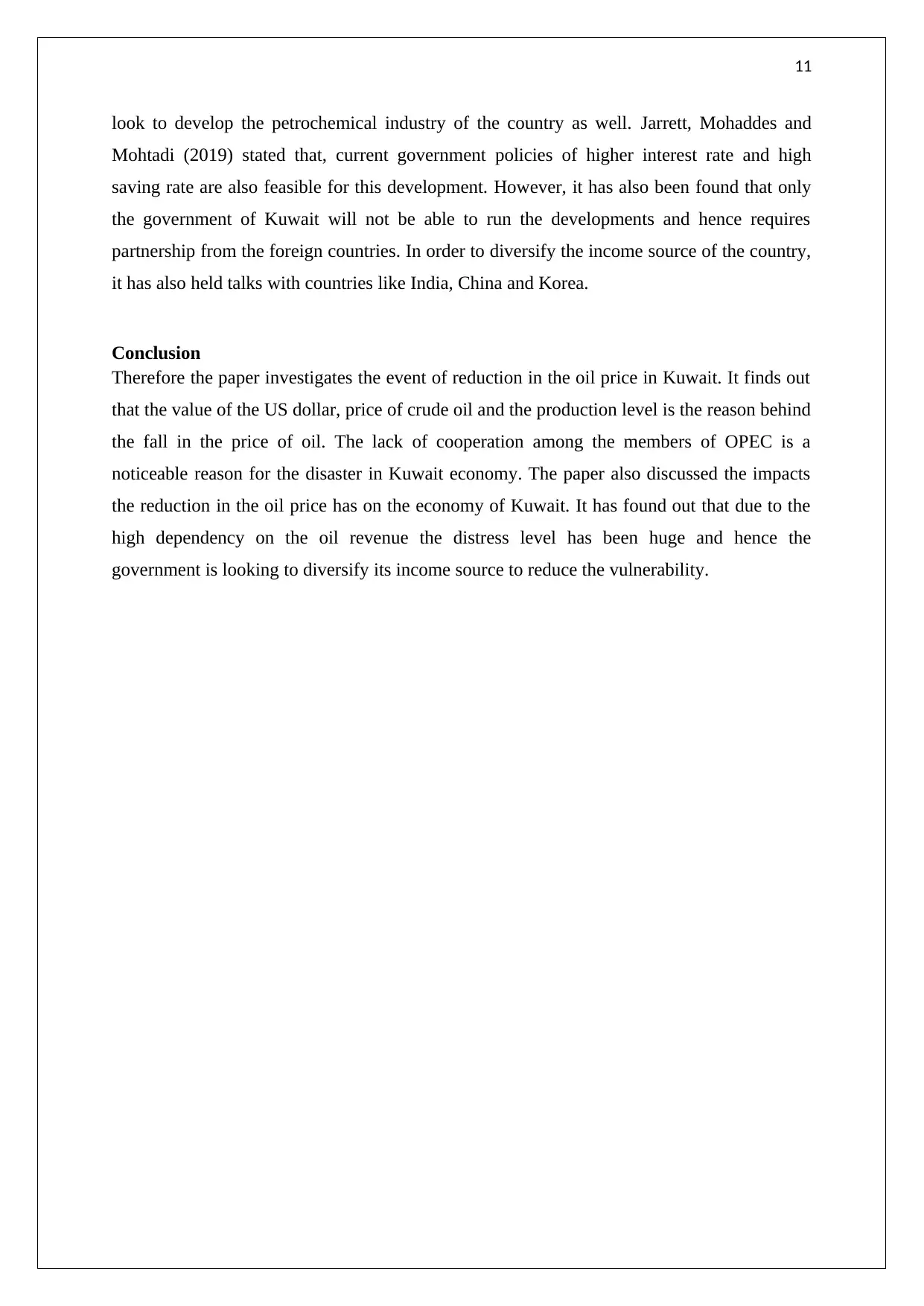
11
look to develop the petrochemical industry of the country as well. Jarrett, Mohaddes and
Mohtadi (2019) stated that, current government policies of higher interest rate and high
saving rate are also feasible for this development. However, it has also been found that only
the government of Kuwait will not be able to run the developments and hence requires
partnership from the foreign countries. In order to diversify the income source of the country,
it has also held talks with countries like India, China and Korea.
Conclusion
Therefore the paper investigates the event of reduction in the oil price in Kuwait. It finds out
that the value of the US dollar, price of crude oil and the production level is the reason behind
the fall in the price of oil. The lack of cooperation among the members of OPEC is a
noticeable reason for the disaster in Kuwait economy. The paper also discussed the impacts
the reduction in the oil price has on the economy of Kuwait. It has found out that due to the
high dependency on the oil revenue the distress level has been huge and hence the
government is looking to diversify its income source to reduce the vulnerability.
look to develop the petrochemical industry of the country as well. Jarrett, Mohaddes and
Mohtadi (2019) stated that, current government policies of higher interest rate and high
saving rate are also feasible for this development. However, it has also been found that only
the government of Kuwait will not be able to run the developments and hence requires
partnership from the foreign countries. In order to diversify the income source of the country,
it has also held talks with countries like India, China and Korea.
Conclusion
Therefore the paper investigates the event of reduction in the oil price in Kuwait. It finds out
that the value of the US dollar, price of crude oil and the production level is the reason behind
the fall in the price of oil. The lack of cooperation among the members of OPEC is a
noticeable reason for the disaster in Kuwait economy. The paper also discussed the impacts
the reduction in the oil price has on the economy of Kuwait. It has found out that due to the
high dependency on the oil revenue the distress level has been huge and hence the
government is looking to diversify its income source to reduce the vulnerability.
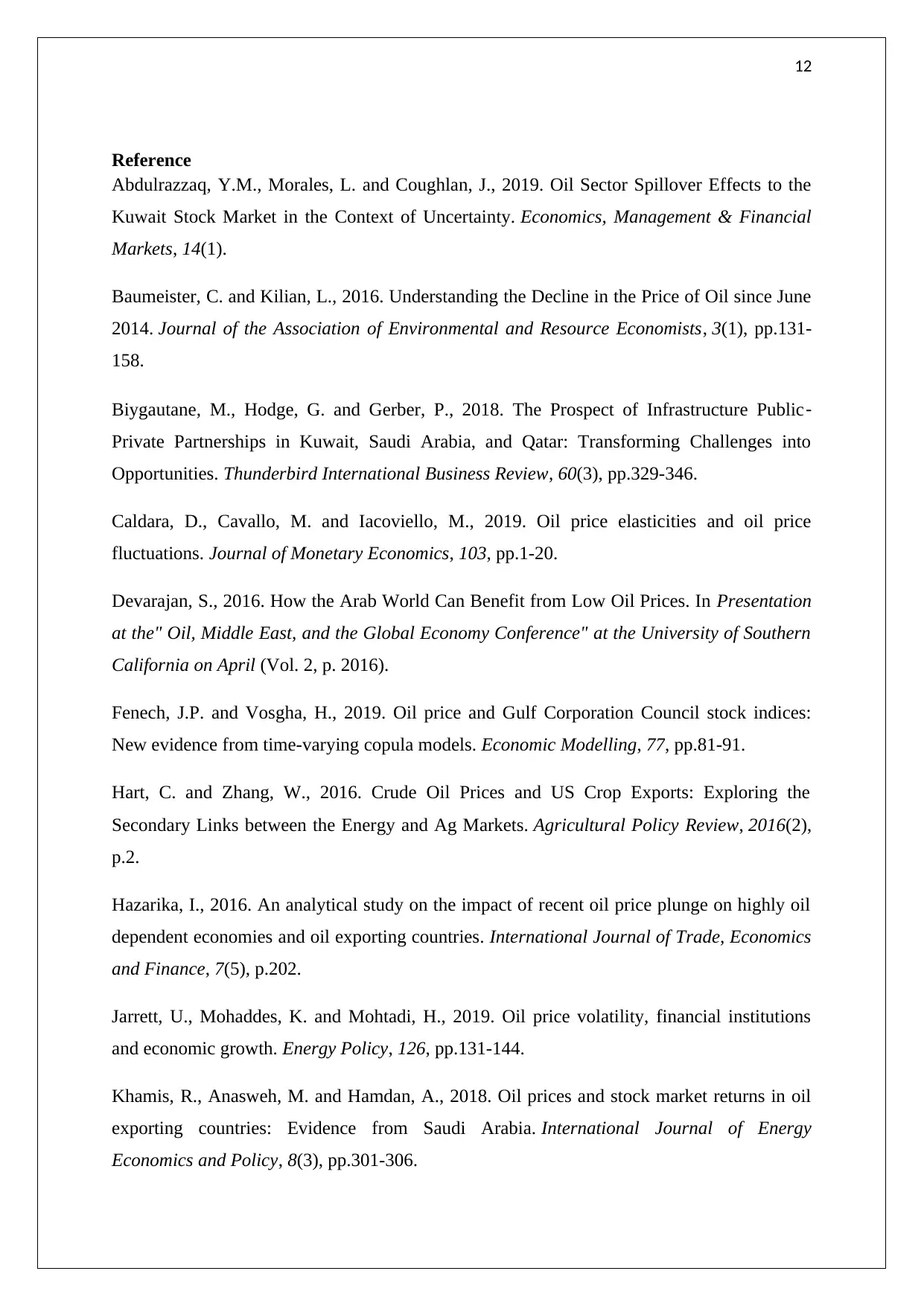
12
Reference
Abdulrazzaq, Y.M., Morales, L. and Coughlan, J., 2019. Oil Sector Spillover Effects to the
Kuwait Stock Market in the Context of Uncertainty. Economics, Management & Financial
Markets, 14(1).
Baumeister, C. and Kilian, L., 2016. Understanding the Decline in the Price of Oil since June
2014. Journal of the Association of Environmental and Resource Economists, 3(1), pp.131-
158.
Biygautane, M., Hodge, G. and Gerber, P., 2018. The Prospect of Infrastructure Public‐
Private Partnerships in Kuwait, Saudi Arabia, and Qatar: Transforming Challenges into
Opportunities. Thunderbird International Business Review, 60(3), pp.329-346.
Caldara, D., Cavallo, M. and Iacoviello, M., 2019. Oil price elasticities and oil price
fluctuations. Journal of Monetary Economics, 103, pp.1-20.
Devarajan, S., 2016. How the Arab World Can Benefit from Low Oil Prices. In Presentation
at the" Oil, Middle East, and the Global Economy Conference" at the University of Southern
California on April (Vol. 2, p. 2016).
Fenech, J.P. and Vosgha, H., 2019. Oil price and Gulf Corporation Council stock indices:
New evidence from time-varying copula models. Economic Modelling, 77, pp.81-91.
Hart, C. and Zhang, W., 2016. Crude Oil Prices and US Crop Exports: Exploring the
Secondary Links between the Energy and Ag Markets. Agricultural Policy Review, 2016(2),
p.2.
Hazarika, I., 2016. An analytical study on the impact of recent oil price plunge on highly oil
dependent economies and oil exporting countries. International Journal of Trade, Economics
and Finance, 7(5), p.202.
Jarrett, U., Mohaddes, K. and Mohtadi, H., 2019. Oil price volatility, financial institutions
and economic growth. Energy Policy, 126, pp.131-144.
Khamis, R., Anasweh, M. and Hamdan, A., 2018. Oil prices and stock market returns in oil
exporting countries: Evidence from Saudi Arabia. International Journal of Energy
Economics and Policy, 8(3), pp.301-306.
Reference
Abdulrazzaq, Y.M., Morales, L. and Coughlan, J., 2019. Oil Sector Spillover Effects to the
Kuwait Stock Market in the Context of Uncertainty. Economics, Management & Financial
Markets, 14(1).
Baumeister, C. and Kilian, L., 2016. Understanding the Decline in the Price of Oil since June
2014. Journal of the Association of Environmental and Resource Economists, 3(1), pp.131-
158.
Biygautane, M., Hodge, G. and Gerber, P., 2018. The Prospect of Infrastructure Public‐
Private Partnerships in Kuwait, Saudi Arabia, and Qatar: Transforming Challenges into
Opportunities. Thunderbird International Business Review, 60(3), pp.329-346.
Caldara, D., Cavallo, M. and Iacoviello, M., 2019. Oil price elasticities and oil price
fluctuations. Journal of Monetary Economics, 103, pp.1-20.
Devarajan, S., 2016. How the Arab World Can Benefit from Low Oil Prices. In Presentation
at the" Oil, Middle East, and the Global Economy Conference" at the University of Southern
California on April (Vol. 2, p. 2016).
Fenech, J.P. and Vosgha, H., 2019. Oil price and Gulf Corporation Council stock indices:
New evidence from time-varying copula models. Economic Modelling, 77, pp.81-91.
Hart, C. and Zhang, W., 2016. Crude Oil Prices and US Crop Exports: Exploring the
Secondary Links between the Energy and Ag Markets. Agricultural Policy Review, 2016(2),
p.2.
Hazarika, I., 2016. An analytical study on the impact of recent oil price plunge on highly oil
dependent economies and oil exporting countries. International Journal of Trade, Economics
and Finance, 7(5), p.202.
Jarrett, U., Mohaddes, K. and Mohtadi, H., 2019. Oil price volatility, financial institutions
and economic growth. Energy Policy, 126, pp.131-144.
Khamis, R., Anasweh, M. and Hamdan, A., 2018. Oil prices and stock market returns in oil
exporting countries: Evidence from Saudi Arabia. International Journal of Energy
Economics and Policy, 8(3), pp.301-306.
⊘ This is a preview!⊘
Do you want full access?
Subscribe today to unlock all pages.

Trusted by 1+ million students worldwide
1 out of 13
Related Documents
Your All-in-One AI-Powered Toolkit for Academic Success.
+13062052269
info@desklib.com
Available 24*7 on WhatsApp / Email
![[object Object]](/_next/static/media/star-bottom.7253800d.svg)
Unlock your academic potential
Copyright © 2020–2025 A2Z Services. All Rights Reserved. Developed and managed by ZUCOL.




